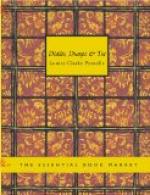“I ac’ nigger moshuns” was represented by scratching his head, or by bending over and pretending to be picking cotton or hoeing.
The representation of the different motions was left entirely to the taste and ingenuity of the actor, though it was the rule of the game that no two people should represent the same character in the same way. If one acted the lady by a mincing walk, the next one must devise some other manner of portraying her, such as sewing, or playing on an imaginary piano, or giving orders to servants, or any thing that his fancy would suggest.
The middle man or woman was always selected for his or her skill in taking off the different characters; and when they were clever at it, the game was very amusing to a spectator.
After one or two games of “Monkey Moshuns,” some one proposed they should play “Lipto,” which was readily acceded to.
All joined hands, and formed a ring around one in the middle, as before, and danced around, singing,
“Lipto, lipto, jine de ring;
Lipto, lipto, dance an’ sing;
Dance an’ sing, an’
laugh an’ play,
Fur dis is now er halerday.”
Then, letting loose hands, they would all wheel around three times, singing,
“Turn erroun’ an’ roun’ an’ roun’;”
then they would clap their hands, singing,
“Clap yer han’s, an’ make’ em soun’;”
then they would bow their heads, singing,
“Bow yer heads, an’ bow ’em low;”
then, joining hands again, they would dance around, singing,
“All jine han’s, an’ hyear we go.”
And now the dancers would drop hands once more, and go to patting, while one of the men would step out with a branch of honeysuckle or yellow jessamine, or something twined to form a wreath, or a paper cap would answer, or even one of the boys’ hats— anything that would serve for a crown; then he would sing,
“Lipto, lipto— fi-yi-yi;
Lipto, lipto, hyear am I,
Er holdin’ uv dis goldin’
crown,
An’ I choose my gal fur ter
dance me down.”
Then he must place the crown on the head of any girl he chooses, and she must step out and dance with him, or, as they expressed it, “set to him” (while all the rest patted), until one or the other “broke down,” when the man stepped back in the ring, leaving the girl in the middle, then they all joined hands, and began the game over again, going through with the wheeling around and clapping of hands and the bowing of heads just as before; after which the girl would choose her partner for a “set to,” the song being the same that was sung by the man, with the exception of the last line, which was changed to
“An’ I choose my man fur ter dance me down.”
“Lipto” was followed by “De One I Like de Bes’,” which was a kissing game, and gave rise to much merriment. It was played, as the others were, by the dancers joining hands and forming a ring, with some one in the middle, and singing,




